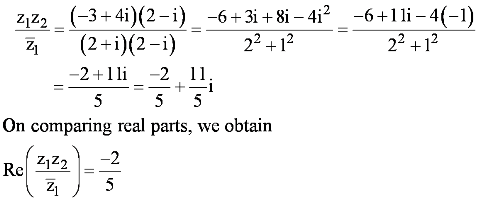Question 4:
Solve 3x + 8 > 2, when
(i) x is an integer (ii) x is a real number
Answer
The given inequality is 3x + 8 > 2.
3x + 8 > 2
⇒ 3x + 8 – 8 > 2 – 8
⇒ 3x > −6
Exams Question Papers General Knowledge Election Directory
Question 4:
Solve 3x + 8 > 2, when
(i) x is an integer (ii) x is a real number
Answer
The given inequality is 3x + 8 > 2.
3x + 8 > 2
⇒ 3x + 8 – 8 > 2 – 8
⇒ 3x > −6
Question 3:
Solve 5x– 3 < 7, when
(i) x is an integer (ii) x is a real number
Answer
The given inequality is 5x– 3 < 7.
−12x > 30
⇒ 5x – 3 + 3 < 7 + 3
⇒ 5x < 10

(i) The integers less than 2 are …, –4, –3, –2, –1, 0, 1.
Thus, when x is an integer, the solutions of the given inequality are …, –4, –3, –2, –1, 0, 1.
Hence, in this case, the solution set is {…, –4, –3, –2, –1, 0, 1}.
(ii) When x is a real number, the solutions of the given inequality are given by x < 2,
that is, all real numbers x which are less than 2.
Thus, the solution set of the given inequality is x ∈ (–∞, 2).
Question 2:
Solve –12x > 30, when
(i) x is a natural number (ii) x is an integer
Answer
The given inequality is –12x > 30.
−12x > 30

(i) There is no natural number less than (−5/2).
Thus, when x is a natural number, there is no solution of the given inequality.
(ii) The integers less than (−5/2) are …, –5, –4, –3.
Thus, when x is an integer, the solutions of the given inequality are …, –5, –4, –3.
Hence, in this case, the solution set is {…, –5, –4, –3}.
Question 1:
Solve 24x < 100, when (i) x is a natural number (ii) x is an integer
Answer
The given inequality is 24x < 100
24x < 100

(i) It is evident that 1, 2, 3, and 4 are the only natural numbers less than 25/6.
Thus, when x is a natural number, the solutions of the given inequality are 1, 2, 3, and 4.
Hence, in this case, the solution set is {1, 2, 3, 4}.
(ii) The integers less than 25/6 are … are …–3, –2, –1, 0, 1, 2, 3, 4.
Thus, when x is an integer, the solutions of the given inequality are …–3, –2, –1, 0, 1, 2, 3, 4.
Hence, in this case, the solution set is {…–3, –2, –1, 0, 1, 2, 3, 4}.
Question 20:

Answer


∴ m = 4k, where k is some integer.
Therefore, the least positive integer is 1.
Thus, least positive integral value of m is 4(= 4 ×1).
Question 19:
If (a + ib) (c + id) (e + if) (g + ih) = A + iB, then show that (a2 + b2) (c2 + d2) (e2 + f2) (g2 + h2) = A2 + B2.
Answer
(a + ib) (c + id) (e + if) (g + ih) =A + IB’
∴ |(a + ib) (c + id) (e + if) (g + ih)| = |A + iB|
⇒ |(a + ib) ×|(c + id)| × |(e + if | × |(g + ih)| = |A + iB| [|z1z2| = |z1||z2|]
![]()
On squaring both sides, we obtain
(a2 + b2) (c2 + d2) (e2 + f2) (g2 + h2) = A2 + B2
Hence, proved.
Question 18:
Find the number of non-zero integral solutions of the equation |1 –i|x = 2x It is given that, |β| = 1
Answer
|1 – i|x = 2x

Thus, 0 is the only integral solution of the given equation. Therefore, the number of non-zero integral solutions of the given equation is 0.
Question 17:
If α and β are different complex numbers with |β| = 1, then find

Answer
Let a = a + ib and β = x + iy
It is given that, |β| = 1



Question 16:

Answer
(x + iy)3 = u + iv
⇒ x3 + (iy)3 + 3 ∙ x ∙ iy(x + iy) = u + iv
⇒ x3 + i3y3 + 3x2yi + 3xy2i2 = u + iv
⇒ x3 – iy3 + 3x2yi− 3xy2 = u + iv
⇒ (x3 – 3xy2) + i(3x2y – y3) = u + iv
On equating real and imaginary parts, we obtain
u = x3 – 3xy2, v = 3x2y – y3

Question 14:
Find the real numbers x and y if (x – iy) (3 + 5i) is the conjugate of −6 – 24i.
Answer
Let z = (x – iy) (3 + 5i)
z = 3x + 5xi – 3yi – 5yi2 = 3x + 5xi – 3yi + 5y = (3x + 5y) + i(5x – 3y)

∴ (3x + 5y) – i(5x – 3y) = −6 – 24i
Equating real and imaginary parts, we obtain
3x + 5y = −6 ….(i)
5x – 3y = 24 ….(ii)
Multiplying equation (i) by 3 and equation (ii) by 5 and then adding them, we obtain 9x + 15y = −18

Putting the value of x in equation (i), we obtain
3(3) + 5y = −6
⇒ 5y = −6 – 9 = −15
⇒ y = −3
Thus, the values of x and y are 3 and −3 respectively.
Question 13:

Answer

Let z = r cos θ + ir sin θ
i.e., r cos θ = −1/2 and r sin θ = 1/2
On squaring and adding, we obtain

Therefore, the modulus and argument of the given complex number are 1/√2 and 3π/4 respectively.
Question 12:
Let z1 = 2 – i, z2 = −2 + i. Find

Answer
z1 = 2 – i, z2 = −2 + i
(i) z1z2 = (2 – i) (−2 + i) = −4 + 2i + 2i – i2 = −4 + 4i – (−1) = −3 + 4i



Question 9 :
Solve the equation 21x2 – 28x + 10 = 0
Answer
The given quadratic equation is 21x2 – 28x + 10 = 0
On comparing the given equation with ax2 + bx + c = 0, we obtain
a = 21, b = −28, and c = 10
Therefore, the discriminant of the given equation is
D = b2 – 4ac = (−28)2 – 4 × 21 × 10 = 784 – 840 = −56
Therefore, the required solutions are

Question 8:
Solve the equation 27x2 – 10x + 1 = 0
Answer
The given quadratic equation is 27x2 – 10x + 1 = 0
On comparing the given equation with ax2 + bx + c = 0, we obtain
a = 27, b = −10, and c = 1
Therefore, the discriminant of the given equation is
D = b2 – 4ac =(−10)2 – 4 × 27 × 1 = 100 – 108 = −8
Therefore, the required solutions are

Question 7:

Answer

This equation can also be written as 2x3 – 4x + 3 = 0
On comparing this equation with ax2 + bx + c = 0, we obtain
a = 2, b = −4, and c = 3
Therefore, the discriminant of the given equation is
D = b2 – 4ac = (−4)2 – 4 × 2 × 3 = 16 – 24 = −8
Therefore, the required solutions are

Question 6:

Answer

This equation can also be written as 9x2 – 12x + 20 = 0
On comparing this equation with ax2 + bx + c = 0, we obtain
a = 9, b = −12, and c = 20
Therefore, the discriminant of the given equation is
D = b2 – 4ac = (−12)2 – 4 × 9 × 20 = 144 – 720 = −576

Question 5:
Convert the following in the polar form :

Answer

Let r cos θ = −1 and r sin θ = 1
On squaring and adding, we obtain
r2(cos2 θ + sin2 θ) = 1 + 1
⇒ r2(cos2 θ + sin2 θ) = 1 + 1
⇒ r2(cos2 θ + sin2 θ) = 2
⇒ r2 = 2 [cos2 θ + sin2 θ = 1]
⇒ r = √2 [Conventionally, r > 0]
∴ √2 cos θ = −1 and √2 sin θ = 1


Let r cos θ = −1 and r sin θ = 1
On squaring and adding, we obtain
r2(cos2 θ + sin2 θ)=1 + 1
⇒ r2(cos2 θ + sin2 θ) = 2
⇒ r2 = 2 [cos2 θ + sin2 θ = 1]
⇒ r = √2 [Conventionally, r > 0]
∴ √2 cos θ =−1 and √2 sin θ = 1

This is the required polar form.